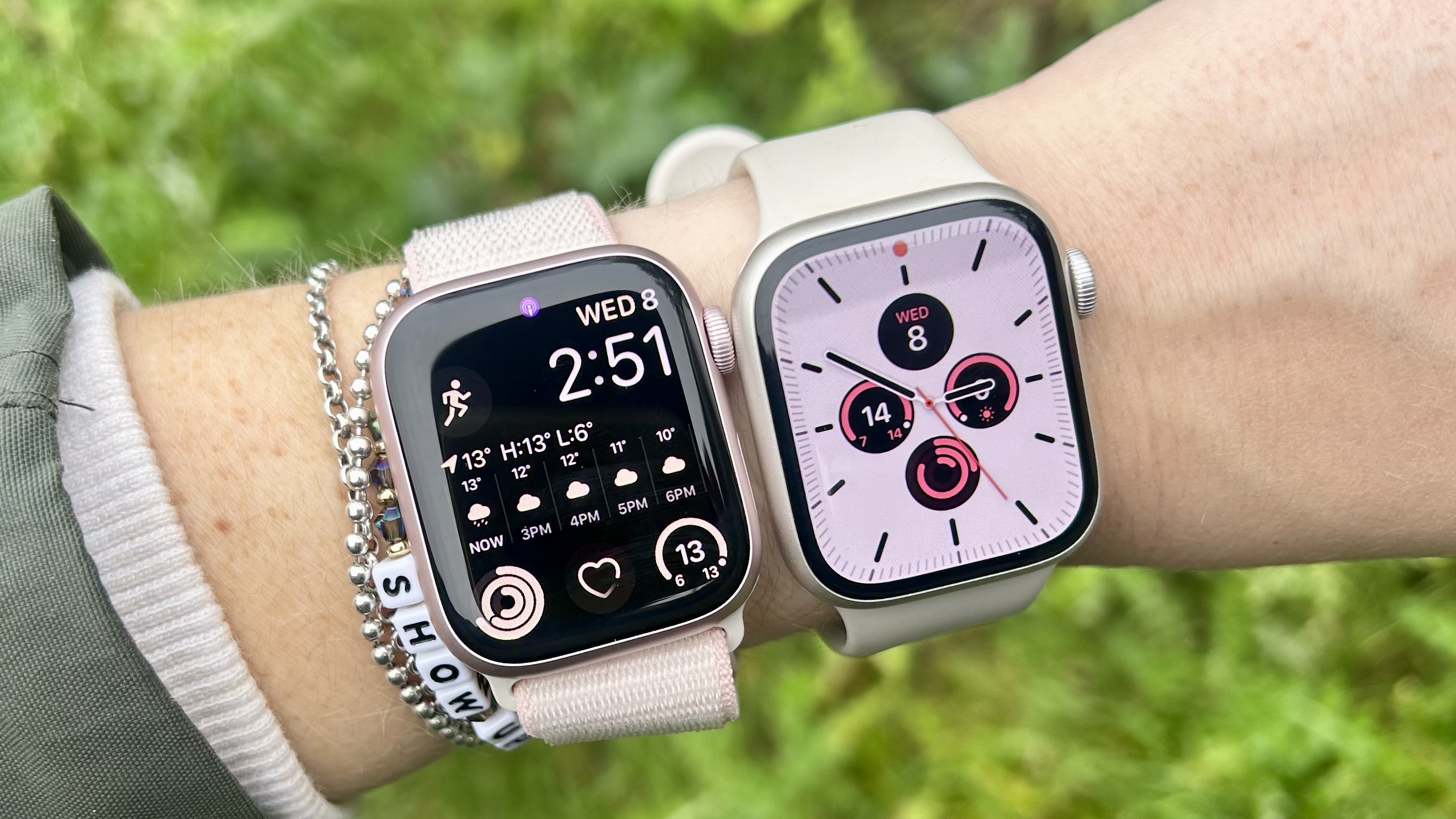I walked 5,000 steps with the Apple Watch 9 and Apple Watch 8 — and the results are surprising
I put the two Apple Watches head-to-head

As Tom’s Guide’s Fitness Editor, I love nothing more than putting some of the best fitness trackers on the market head-to-head. Fans of Tom’s Guide will know this isn’t the first time I’ve strapped two watches to my wrist and headed out for a walk, and it probably won’t be the last. Next up on the list was the Apple Watch Series 9 vs the older Apple Watch Series 8 — which watch would be more accurate over 5,000 steps? Read on to find out.
On the wrist, the Apple Watch Series 9 and the Apple Watch Series 8 look pretty much identical, although there’s one big difference between the two watches, and that’s behind the screen. The Apple Watch 9 has Apple’s new S9 processor and U2 ultrawide-band chip. The processor enables a pretty neat trick: When you're wearing the watch, you can double-tap your index finger and thumb to enable certain features, such as answering and hanging up calls, launch widgets, and more. It should come in handy for those times when your other hand is otherwise occupied, but you need to activate something on your Apple Watch.
Both watches will count your steps in the same way — tracking your arm motion using the built-in accelerometer, to estimate how many steps you’ve taken. For best results, you should allow the arm you’re wearing your watch on to swing naturally as you move, as well as calibrating your watch to improve the accuracy of the estimations.
As a reminder, no fitness tracker will be 100% accurate when it comes to estimating the amount of steps you’ve taken. Over time, your Apple Watch will use recorded data to get a more accurate understanding of your average running and walking pace. Yet, you can also manually calibrate your watch, which will help it learn your stride, and therefore be more accurate when GPS is limited or unavailable. Here’s more on how to calibrate your Apple Watch.
I walked 5,000 steps with the Apple Watch 9 and Apple Watch 8 — here’s which was more accurate
So, what happened when I walked 5,000 steps with both watches? To test whether there was any difference in how accurately the Apple Watch 9 and Apple Watch 8 counted my steps, I strapped both to my wrist and manually counted out 5,000 steps. To avoid losing count as I walked, I used a $6.99 tally counter tool from Amazon and clicked each time I took a step. When I got home, I compared the data from the two watches.
I remembered from my test with the Apple Watch 9 and the Apple Watch Ultra 2 that whichever watch was connected to my iPhone was slightly more accurate, so I connected my Apple Watch 9 to my iPhone 14, and my Apple Watch 8 to an older iPhone 11.
I’ve learned in the past that Apple makes it nearly impossible to view your exact amount of steps per workout. Sure, you can see your daily total in the Fitness app, and you can find hourly step data in the Health app, but to make things a little less confusing, I downloaded the StepsApp Pedometer app on both Apple Watches.
Sign up to get the BEST of Tom's Guide direct to your inbox.
Get instant access to breaking news, the hottest reviews, great deals and helpful tips.
The results
| Header Cell - Column 0 | Steps |
|---|---|
| Manual recording | 5,000 |
| Apple Watch 9 | 4,951 |
| Apple Watch 8 | 4,835 |
As you can see from the results, the Apple Watch 9 only missed around 50 steps, which is pretty accurate for a fitness tracker. I walked for 2.8 miles, which means I take around 1,600 steps per mile, so 49 steps isn’t all that many at all. The Apple Watch 8 missed considerably more steps at 165. You can read what happened when I walked with the Apple Watch Series 9 and the Fitbit Charge 6 here, as well as when I did 5,000 steps with the Apple Watch Series 8 and the Garmin Forerunner 265.
As I always write when I complete these challenges — fitness trackers do a lot more than just tracking your steps, and counting steps alone isn’t the best metric when it comes to getting fitter and losing weight. That said, it’s a good place to start. While that the target of 10,000 steps began as a piece of marketing in 1965 by a Japanese company that was about to introduce a device called a Manpo-kei (it means 10,000-steps meter), it is a useful goal — a review of 32 studies, published in the International Journal of Behavioral Nutrition and Physical Activity found that “10,000 steps/day is a reasonable target for healthy adults.”
There are lots of benefits to walking more, including losing weight, building muscle, and feeling less stressed and 10,000 steps can be an achievable goal to help you get healthier. Compared to some of the best fitness trackers on the market, Apple does a good job of keeping you motivated with move reminders, and those all-important rings, which really do inspire you to move more.
If you’re looking to invest in one of the best Apple Watches, check out our Apple Watch 9 review and our Apple Watch 8 review here on Tom’s Guide.
More from Tom's Guide

Jane McGuire is Tom's Guide's Fitness editor, which means she looks after everything fitness related - from running gear to yoga mats. An avid runner, Jane has tested and reviewed fitness products for the past five years, so knows what to look for when finding a good running watch or a pair of shorts with pockets big enough for your smartphone. When she's not pounding the pavements, you'll find Jane striding round the Surrey Hills, taking far too many photos of her puppy.
